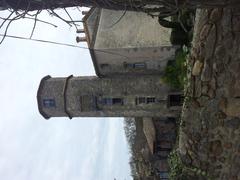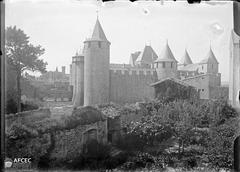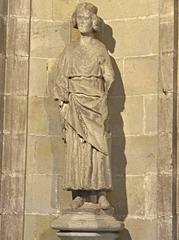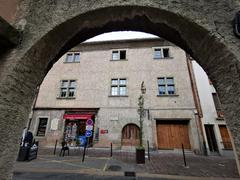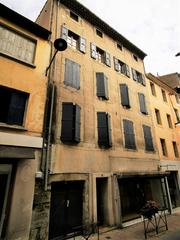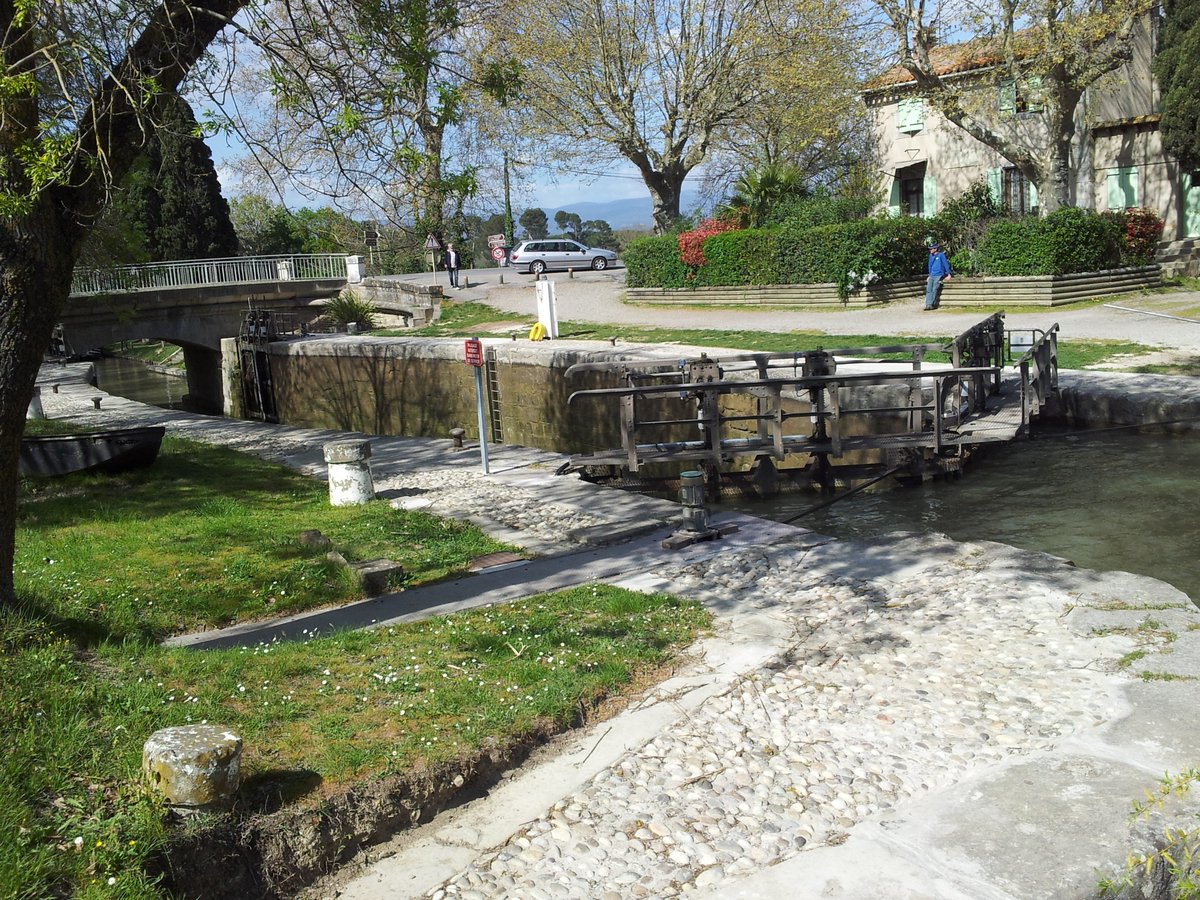
Visiting Écluse De Saint-Jean in Carcassonne: Hours, Tickets, and Tips
Date: 17/08/2024
Introduction
Explore the Écluse de Saint-Jean, a hidden gem nestled on the Canal du Midi in Carcassonne, France. This comprehensive guide delves into its rich historical background, vital visitor information, and helpful travel tips to ensure an unforgettable visit. The Écluse de Saint-Jean, a single-chamber lock constructed around 1674 during King Louis XIV’s reign, is part of the ambitious Canal du Midi project designed by the French engineer Pierre-Paul Riquet. The canal itself, a UNESCO World Heritage Site, stretches 360 kilometers, connecting the Mediterranean Sea to the Atlantic Ocean and stands as a testament to the ingenuity of 17th-century civil engineering (JJ Bucket List Travellers). The canal not only played a crucial role in the economic and strategic landscape of France but also facilitated the transport of goods and people across the country, significantly reducing travel time between the Atlantic and the Mediterranean (Wikipedia). Today, the Écluse de Saint-Jean continues to captivate visitors with its historical significance, architectural marvels, and the scenic beauty of its surroundings.
Table of Contents
- Introduction
- Historical Background
- Visitor Information
- Role in Local Economy
- Travel Tips and Nearby Attractions
- Cultural Significance
- Visitor Experience
- Conclusion
- References
Historical Background
Construction and Early History
The Écluse de Saint-Jean is a single-chamber lock on the Canal du Midi, located in the commune of Carcassonne, France. This lock was constructed around 1674, during the reign of King Louis XIV, as part of the ambitious Canal du Midi project. The canal itself was designed by the French engineer Pierre-Paul Riquet and built between 1667 and 1694. The Canal du Midi is one of the great civil engineering works of the modern era, stretching 360 kilometers and connecting the Mediterranean Sea to the Atlantic Ocean (JJ Bucket List Travellers).
Strategic Importance
The Canal du Midi, including the Écluse de Saint-Jean, played a crucial role in the economic and strategic landscape of France. It facilitated the transport of goods and people across the country, significantly reducing the travel time between the Atlantic and the Mediterranean. The canal’s construction was a monumental task, involving the creation of 328 structures, including locks, aqueducts, bridges, and tunnels (JJ Bucket List Travellers).
Engineering Marvel
The Écluse de Saint-Jean, like other locks on the Canal du Midi, is an engineering marvel. It operates by transferring water from one basin to another, allowing boats to navigate the varying elevations along the canal. This lock is situated at an altitude of 102 meters and is 108 kilometers from Toulouse. The adjacent locks are the double lock of Fresquel to the east and the Carcassonne lock to the west (Wikipedia).
Restoration and Preservation
In the mid-19th century, the French government considered demolishing many of the canal’s structures, including the locks, due to their deteriorating condition. However, a preservation campaign led by local citizens and notable figures such as Jean-Pierre Cros-Mayrevieille and Prosper Mérimée successfully halted these plans. The architect Eugène Viollet-le-Duc was commissioned to restore the canal and its locks, ensuring their preservation for future generations (Spotting History).
UNESCO World Heritage Site
The Canal du Midi, including the Écluse de Saint-Jean, was designated a UNESCO World Heritage Site in 1996. This recognition underscores the canal’s historical, cultural, and engineering significance. The canal is celebrated for its innovative design and the role it played in the development of inland water transport in France (JJ Bucket List Travellers).
Architectural Features
The Écluse de Saint-Jean is characterized by its single-chamber design, which was typical of the locks constructed during the 17th century. The lock’s walls are made of stone, and it features wooden gates that are manually operated. The lock chamber itself is designed to accommodate the traditional barges that once plied the Canal du Midi, although today it also serves modern recreational boats (Tourisme Carcassonne).
Visitor Information
Visiting Hours and Tickets
The Écluse de Saint-Jean is accessible year-round. However, it’s recommended to check the local tourist information center for specific visiting hours as they may vary. There are no entrance fees for the lock itself, but guided tours may have associated costs (Tourisme Occitanie).
Accessibility
The lock is accessible on foot, by bike, or by boat. The pathways around the lock are generally well-maintained, making it accessible for visitors with mobility issues. There are also designated parking areas nearby for those traveling by car (Grand Carcassonne Tourist Information Center).
Role in Local Economy
Modern Usage
In contemporary times, the Écluse de Saint-Jean continues to be an important part of the Canal du Midi’s infrastructure. It is used primarily by recreational boaters who navigate the canal for leisure. The lock is also a popular spot for tourists who enjoy watching the lock in operation and learning about its history. The surrounding area offers opportunities for walking, cycling, and picnicking along the canal’s picturesque banks (Tourisme Occitanie).
Travel Tips and Nearby Attractions
Nearby Attractions
While visiting the Écluse de Saint-Jean, consider exploring other historical sites in Carcassonne, such as the famous medieval citadel. The area offers a rich tapestry of history and culture, providing a comprehensive travel experience (Five Minute History).
Unique Experiences
Guided tours are available that offer in-depth insights into the lock’s history and operation. Special events are occasionally held at the lock, providing unique experiences for visitors. Check local event listings for more information (Tourisme Carcassonne).
Cultural Significance
The Écluse de Saint-Jean is not just an engineering feat but also a cultural landmark. It represents the ingenuity and ambition of 17th-century France and stands as a testament to the country’s rich history of civil engineering. The lock and the Canal du Midi are celebrated in literature, art, and local folklore, contributing to the cultural heritage of the region (Five Minute History).
Visitor Experience
Activities
Visitors to the Écluse de Saint-Jean can enjoy a variety of activities. The lock is accessible by foot, bike, or boat, making it a versatile destination for tourists. Guided tours are available, offering insights into the lock’s history and operation. Additionally, the nearby town of Carcassonne provides ample opportunities for dining, shopping, and exploring other historical sites (Grand Carcassonne Tourist Information Center).
FAQ
Q: What are the visiting hours for Écluse de Saint-Jean?
A: The lock is accessible year-round, but specific visiting hours may vary. Check with the local tourist information center for the most accurate information.
Q: How do I buy tickets for Écluse de Saint-Jean?
A: There are no entrance fees for the lock itself, but guided tours may have associated costs. Tickets for tours can be purchased from local tour operators or online.
Conclusion
The Écluse de Saint-Jean is a remarkable historical and engineering landmark that continues to captivate visitors with its rich history and cultural significance. As part of the Canal du Midi, it stands as a testament to the ingenuity of its creators and the enduring legacy of France’s civil engineering achievements. Whether you are a history enthusiast, an engineering aficionado, or simply a curious traveler, the Écluse de Saint-Jean offers a unique and enriching experience. Stay updated with the latest information by following local tourism websites or downloading the Audiala app for more travel tips and guides.
References
- JJ Bucket List Travellers. (n.d.). Best Things to Do in Carcassonne, France. Retrieved from JJ Bucket List Travellers
- Wikipedia. (n.d.). Écluse de Saint-Jean. Retrieved from Wikipedia
- Spotting History. (n.d.). Historic Fortified City of Carcassonne. Retrieved from Spotting History
- Tourisme Carcassonne. (n.d.). Écluse de Saint-Jean. Retrieved from Tourisme Carcassonne
- Tourisme Occitanie. (n.d.). Écluse de Saint-Jean, Carcassonne. Retrieved from Tourisme Occitanie
- Grand Carcassonne Tourist Information Center. (n.d.). Écluse de Saint-Jean. Retrieved from Grand Carcassonne Tourist Information Center
- Thrillophilia. (n.d.). Écluse de Carcassonne. Retrieved from Thrillophilia
- Five Minute History. (n.d.). 10 Amazing Facts About the French Medieval City of Carcassonne. Retrieved from Five Minute History
- France Travel Tips. (n.d.). Visit Carcassonne. Retrieved from France Travel Tips
- Petit Futé. (n.d.). Les écluses de Carcassonne. Retrieved from Petit Futé
- My Life Long Holiday. (n.d.). Carcassonne, France. Retrieved from My Life Long Holiday
- History Hit. (n.d.). Cité de Carcassonne. Retrieved from History Hit
- The Crazy Tourist. (n.d.). 15 Best Things to Do in Carcassonne. Retrieved from The Crazy Tourist
- Komoot. (n.d.). Attractions Around Carcassonne. Retrieved from Komoot
- History Skills. (n.d.). Carcassonne. Retrieved from History Skills
- Tourisme Carcassonne. (n.d.). Guided Tours. Retrieved from Tourisme Carcassonne



